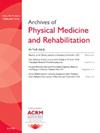Peripheral Electrical Stimulation on Motor Function and Activities of Daily Living After Stroke: A Systematic Review and Network Meta-analysis
IF 3.7
2区 医学
Q1 REHABILITATION
Archives of physical medicine and rehabilitation
Pub Date : 2025-08-01
DOI:10.1016/j.apmr.2025.01.466
引用次数: 0
Abstract
Objective
To compare the effects of different peripheral electrical stimulation protocols and current frequencies for poststroke motor function and activities of daily living.
Data Sources
Seven databases (PubMed, Embase, Cochrane Library, Chinese National Knowledge Infrastructure, VIP Database, Wan-Fang Database, and Chinese Biomedical Database) were searched from inception to August 2024.
Study Selection
Two reviewers independently performed the literature selection. The included studies were randomized controlled trials providing peripheral electrical stimulation for patients with stroke.
Data Extraction
Two reviewers independently extracted data following a predeveloped Excel data collection sheet, including trial characteristics, intervention and comparator details, and outcome data. The risk of bias was evaluated by RoB2 tool, and the PRISMA guidelines were followed for reporting.
Data Synthesis
A total of 106 trials with 7513 participants were included. Meta-analysis showed that neuromuscular electrical stimulation (NMES) could be the optimal electrical stimulation protocol for improving the Fugl-Meyer Assessment score (standardized mean difference=1.67; 95% confidence interval [1.14-2.21]) and the modified Barthel Index score (standardized mean difference=1.73; 95% confidence interval [1.10-2.37]). The results showed that different frequencies of electrical stimulation ranked the top 5 in descending order for improving: (1) the Fugl-Meyer Assessment scores as follows: 20-30 Hz_NMES (surface under the cumulative ranking curve [SUCRA]=87.5%)>100 Hz_NMES (SUCRA=75.4%)>100 Hz_functional electrical stimulation (SUCRA=70.9%)>20/35 Hz_transcutaneous electrical acupoint stimulation (SUCRA=69.8%)>1-4 Hz_electrical acupuncture (SUCRA=69.6%) and (2) the modified Barthel Index scores as follows: 100 Hz_transcutaneous electrical nerve stimulation (SUCRA=77.3%)>5/15 Hz_NMES (SUCRA=68.3%)>100 Hz_transcutaneous electrical acupoint stimulation (SUCRA=65.6%)>35-50 Hz_functional electrical stimulation (SUCRA=64.8%)>1-4 Hz_electrical acupuncture (SUCRA=60.0%).
Conclusions
Adding electrical stimulation based on routine rehabilitation training can improve the motor dysfunction and activities of daily living of patients with stroke. Specifically, NMES with 20-30 Hz improves motor function best, whereas 100 Hz_transcutaneous electrical nerve stimulation improves activities of daily living best.
外周电刺激对中风后运动功能和日常生活活动的影响:一项系统综述和网络荟萃分析。
目的:比较不同外周电刺激方案和电流频率对脑卒中后运动功能和日常生活活动(ADL)的影响。数据来源:检索自建库至2024年8月的7个数据库(PubMed、Embase、Cochrane Library、Chinese National Knowledge Infrastructure、VIP Database、万方Database和Chinese Biomedical Database)。研究选择:两名评论者独立进行文献选择。纳入的研究是为中风患者提供外周电刺激的随机对照试验。数据提取:两名审稿人根据预先制定的Excel数据收集表独立提取数据,包括试验特征、干预和比较者详细信息以及结果数据。采用RoB2评估偏倚风险,报告遵循PRISMA指南。数据综合:共纳入106项试验,7513名受试者。meta分析显示,神经肌肉电刺激(NMES)可能是改善Fugl-Meyer评估(FMA)评分(SMD = 1.67,95% CI(1.14, 2.21))和改善改良Barthel指数(MBI)评分(SMD = 1.73,95% CI(1.10, 2.37))的最佳电刺激方案。结果表明,不同频率的电刺激降序排名前五为改善FMA评分20-30Hz_NMES (SUCRA = 87.5%)> 100 hz_nmes (SUCRA = 75.4%)> 100 hz_functional电刺激(FES) (SUCRA = 70.9%)> 20/35Hz_transcutaneous穴位电刺激(茶)(SUCRA = 69.8%)> 1-4Hz_electrical针灸(EA) (SUCRA = 69.6%),和排名前五的降序排列为提高MBI评分100 hz_transcutaneous电神经刺激(十)(SUCRA = 77.3%)> 5/15Hz_NMES (SUCRA = 68.3%)> 100 hz_teas (SUCRA = 65.6%)> 35-50Hz_FES (SUCRA = 64.8%)> 1-4Hz_EA (SUCRA = 60.0%)。结论:在常规康复训练的基础上增加电刺激可改善脑卒中患者的运动功能障碍和日常生活自理能力。其中,20 ~ 30 Hz的NMES对运动功能的改善效果最好,而100 Hz的TENS对ADL的改善效果最好。
本文章由计算机程序翻译,如有差异,请以英文原文为准。
求助全文
约1分钟内获得全文
求助全文
来源期刊
CiteScore
6.20
自引率
4.70%
发文量
495
审稿时长
38 days
期刊介绍:
The Archives of Physical Medicine and Rehabilitation publishes original, peer-reviewed research and clinical reports on important trends and developments in physical medicine and rehabilitation and related fields. This international journal brings researchers and clinicians authoritative information on the therapeutic utilization of physical, behavioral and pharmaceutical agents in providing comprehensive care for individuals with chronic illness and disabilities.
Archives began publication in 1920, publishes monthly, and is the official journal of the American Congress of Rehabilitation Medicine. Its papers are cited more often than any other rehabilitation journal.

 求助内容:
求助内容: 应助结果提醒方式:
应助结果提醒方式:


